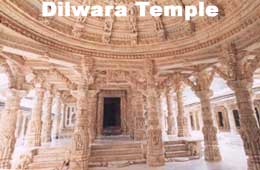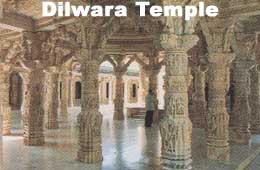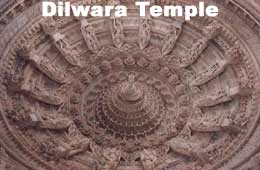| India Profile » Monuments and Temples in India » Dilwara Temple, Mount Abu | |
Dilwara Temple, Mount Abu, Rajasthan | |
 | |
|
The famous Dilwara Jain temples are 2.5 km away from the Mount Abu, which in ancient Hindu and Jain scriptures is referred to as Arbudgiri. The Dilwara temples were dedicated to the Jain tirthankars and also served as storehouses of illustrated manuscripts and treatises. The temples at Mount Abu were constructed between 800 AD and 1200 AD. Traditionally, Gujarat and Rajasthan were the centers of the merchants and princes and became great centers of architectural activities. Vimala Shah, Vastu Pala and Teja Pala contributed a lot toward the development of Jain art and architecture. The Jain temples at Mount Abu are built in the Nagara style of temple architecture. The earliest temple of this group can be dated back to the same period as Brihadeeswar temple at Thanjur in Tamil Nadu. The inscription at Mount Abu suggests that it was basically the seat of Shaivism and Jainism made its appearance in the 11th century AD. The Vimala Vashi temple The Vimal Vashi temple is the earliest and more important of the temples here. It was built in 1021 AD and is dedicated to the first Jain Tirthankara, Adinath. The temple was constructed by Vimal Shah, minister of a local Rajput ruler, Raja Bim Deo. It stands in an open courtyard surrounded by 58 cells or kulikas, which contain small icons of the image in the main shrine. The length of the temple is 98 ft and the width is 42 ft. The main shrine and the front of the cells are surrounded by elaborate columns. The temple is carved out of white marble. The ceiling is decorated with engraved designs of lotus-buds, petals, flowers and scenes from Jain and Hindu mythology. The main shrine is the gold-brass caste image of Adinath placed in the Gudh Mandap. The Rang Mandap is a grand hall, which is supported by 12 decorated pillars. It has nicely carved arches with a beautiful central dome. The pillars are carved with female figurines playing musical instruments and 16 Vidhyadevis or the goddesses of knowledge each holding a symbol of her own. The Navchowki is a collection of 9 rectangular ceilings, each one containing beautiful carvings of various designs supported on ornate pillars. The Gudh Mandap is a simple hall with a heavily decorated doorway. The Hastishala or the Elephant Cell was constructed by Prithvi Pala, a descendant of Vimal Shah in 1147-49 A.D and features a row of elephants in sculpture. The Luna Vashi or the Teja PalaTemple
According to the local legend, the two brothers, before becoming minister, went on a pilgrimage huge wealth, which they decided to bury it under a tree. While digging, they found more gold. Anupama Devi, wife of Teja Pala advised them to build temples at Satrunjaya and Girnar with their wealth. They heard about the holiness of Mount Abu when they were ministers and decided to build a temple there dedicated to Shri Neminath to commemorate their dead brother Luna. The main hall or Rang mandap features a central dome standing on 8 pillars from which hangs a big ornamental pendent featuring elaborate carving. It looks like a cluster of half open lotuses. 72 figures of Tirthankaras in sitting posture are arranged in a circular band. Just below this band another 360 small figures of Jain monks are in another circular band. The sanctum or the garbhagriha has a huge idol of Naminath. There are 39 cells each of which contains one or more images. The ceiling in front of the cell is profusely ornamented. The relief in the porticos of the cell portrays important scenes from the life of Neminath. The Hathishala or the elephant cell features 10 beautiful marble elephants. They are neatly polished and realistically modeled earlier carried the idols representing the family of Vastu Pala. There are 10 slabs behind the elephants bearing a figure of male and female on it. The Navchowki have some of the most magnificent and delicate marble stone cutting work. Each of the 9 ceilings is example of beauty and grace. The Gudh Mandap contains a black marble idol of Neminath. The Kirthi Stambha is a big black stone pillar on the left side of the temple. The pillar was constructed by Maharana Kumbha of Mewar. The Pittalhar Temple The Pittalhar temple was build by Bhima Shah who was a minister of Sultan Begada of Ahmedabad. The temple has a massive metal statue of the Rishab Dev Adinath, cast in five metals. The main metal used in making this statue is 'Pital' (brass), hence the name 'Pittalhar'. The elements of the plan of the temple consist of a garbhagriha, gudh mandap and navchowki. The temple is also known as Shri Rishabh Deoji temple.
The Parshavanath temple is dedicated to Lord Parshavnath. Mandlik and his family built this temple in 1458-59 AD. The temple consists of a three storeyed building, which is the tallest of all the shrines at Dilwara. On the ground floor, all the four faces of the sanctum have four big mandaps. The outer walls of the sanctum are carved with beautiful sculptures of Dikpals, Vidhyadevis, Yakshinis, Shalabhanjikas and other decorative sculptures in gray sandstone. They can be compared to the sculpture in the temples of Khajuraho and Konark. The temple is also known as the Khartar Vashi temple. Mahaveer Swami Temple The Mahaveer Swami temple is a small structure constructed in 1582 AD. It is dedicated to the 24th Jain Tirthankara Lord Mahaveer. The temple is decorated with pictures on the upper walls of the porch painted in 1764 AD by the artists from Sirohi. The other tourist attractions in Mt. Abu include the Bikaner Palace, the Nakki Lake, the Adhar Devi temple, Achalgarh Shiva temple and the Gaumukh Shiva temple. |
|
 |
 Mount Abu is a famous and only hill station of Rajasthan located in the southwest part of Rajasthan. It is a part of the Aravali range. Mount Abu is separated from Aravali by a narrow valley and Guru Shikhar is the highest point towards the northern end. According to legend, Hindus revere this place because once Nandini, the cow of the sage Vashisht was trapped in a deep gorge and could not free itself. The sage asked for Lord Shiva's assistance. Shiva sent Saraswati, the divine stream, to help flood the gorge so that the cow could float up. Sage Vashisht then decided to ensure that such mishaps would not occur in future and asked the youngest son of Himalaya to fill the gorge permanently. He took the help of the snake, Arbud. This spot came to be known as Mount Arbud since then and was later reduced to its present form Mount Abu.
Mount Abu is a famous and only hill station of Rajasthan located in the southwest part of Rajasthan. It is a part of the Aravali range. Mount Abu is separated from Aravali by a narrow valley and Guru Shikhar is the highest point towards the northern end. According to legend, Hindus revere this place because once Nandini, the cow of the sage Vashisht was trapped in a deep gorge and could not free itself. The sage asked for Lord Shiva's assistance. Shiva sent Saraswati, the divine stream, to help flood the gorge so that the cow could float up. Sage Vashisht then decided to ensure that such mishaps would not occur in future and asked the youngest son of Himalaya to fill the gorge permanently. He took the help of the snake, Arbud. This spot came to be known as Mount Arbud since then and was later reduced to its present form Mount Abu.  The Luna Vashi temple is dedicated to the 22nd Tirthankara Shri Nemi Nathji. It resembles the architectural plan of the Vimal Vashi temple although it was built 200 years after that temple. The two brothers, Vastu Pala and Tej Pala, both ministers of a local ruler, built this magnificent temple in 1230 AD. The temple is the among the last few monuments built in the Solanki style, which came to an end towards the end of the 13th century AD with the Muslim occupation of Gujarat.
The Luna Vashi temple is dedicated to the 22nd Tirthankara Shri Nemi Nathji. It resembles the architectural plan of the Vimal Vashi temple although it was built 200 years after that temple. The two brothers, Vastu Pala and Tej Pala, both ministers of a local ruler, built this magnificent temple in 1230 AD. The temple is the among the last few monuments built in the Solanki style, which came to an end towards the end of the 13th century AD with the Muslim occupation of Gujarat. Parshavanath Temple
Parshavanath Temple